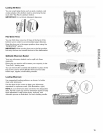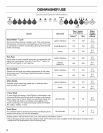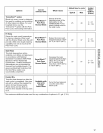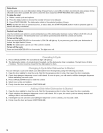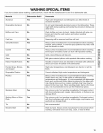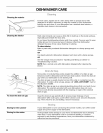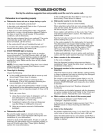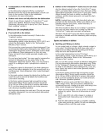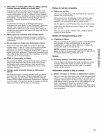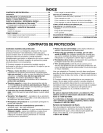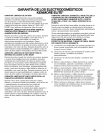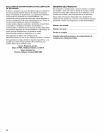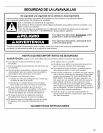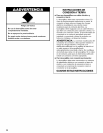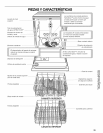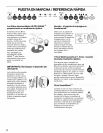
• Silica film or etching (silica film is a milky, rainbow-
colored deposit; etching is a cloudy film)
Sometimes there is a water/chemical reaction with
certain types of glassware. This is usually caused by
some combination of soft or softened water, alkaline
washing solutions, insufficient rinsing, overloading the
dishwasher, and the heat of drying. It might not be
possible to avoid the problem, except by hand
washing.
To slow this process use a minimum amount of
detergent per load. Refer to the "Detergent" dispenser
section. Use a liquid rinse aid and underload the
dishwasher to allow thorough rinsing. Silica film and
etching are permanent and cannot be removed. Do not
use heated drying.
• White spots on cookware with nonstick finish
Has the dishwasher detergent removed cookware
seasoning? Reseason cookware after washing in the
dishwasher.
• Brown stains on dishes and dishwasher interior
Does your water have high iron content? Rewash
dishes using 1-3 tsp (5-15 mL) of citric acid crystals
added to the covered section of the detergent
dispenser. Do not use detergent. Follow with a Normal
wash cycle with detergent. If treatment is needed more
often than every other month, the installation of an iron
removal unit is recommended.
Black or gray marks on dishes
Are aluminum items rubbing dishes during washing?
Disposable aluminum items can break down in the
dishwasher and cause marking. Hand wash these
items. Remove aluminum markings by using a mild
abrasive cleaner.
Orange stains on plastic dishes or dishwasher
interior
Are large amounts of tomato-based foods on dishes
placed in the dishwasher? Stains gradually fade over
time. Regular use of heated drying will slow fading.
Stains will not affect dishwasher performance. Regular
use of a rinse cycle and an air-dry or energy-saving dry
option will reduce the likelihood of staining.
Dishes are not dry
Use of a rinse aid along with the Heated Dry option is
needed for proper drying.
Did you load your dishwasher to allow proper water
drainage? Do not overload. Refer to the "Loading"
section. Use a liquid rinse aid to speed drying.
Are the plastics wet? Plastics often need towel drying.
Is the rinse aid dispenser empty? Refer to the "Rinse
Aid" section.
Did you use an air-dry option? Use a heated drying
option for dryer dishes.
Dishes are damaged during a cycle
• Chipping of dishes
Did you load the dishwasher properly? Load the dishes
and glasses so they are stable and do not strike
together from washing action. Minimize chipping by
moving the rack in and out slowly.
NOTE: Antiques, feather-edged crystal, and similar
types of china and glassware might be too delicate for
automatic dishwashing. Wash by hand.
Noises
Grinding, grating, crunching or buzzing sounds
A hard object has entered the wash module (on some
models). When the object is ground up, the sound
should stop. If the noise persists after a complete
cycle, call for service.
Marks, smudges or residue on dishwasher exterior
Did you clean the dishwasher with a mild detergent and
cloth or use a stainless steel cleaner on models with a
stainless steel exterior? In most cases, regular use of a
soft, damp cloth or sponge and a mild detergent is all
that is necessary to keep the outside of your
dishwasher looking fresh and clean. If your dishwasher
has a stainless steel exterior, a stainless steel cleaner is
recommended.
23



